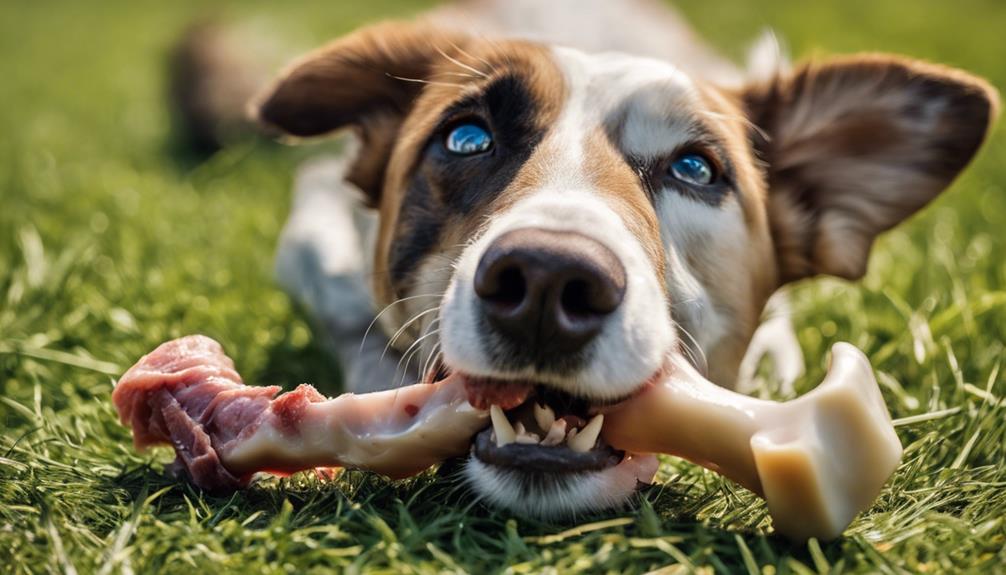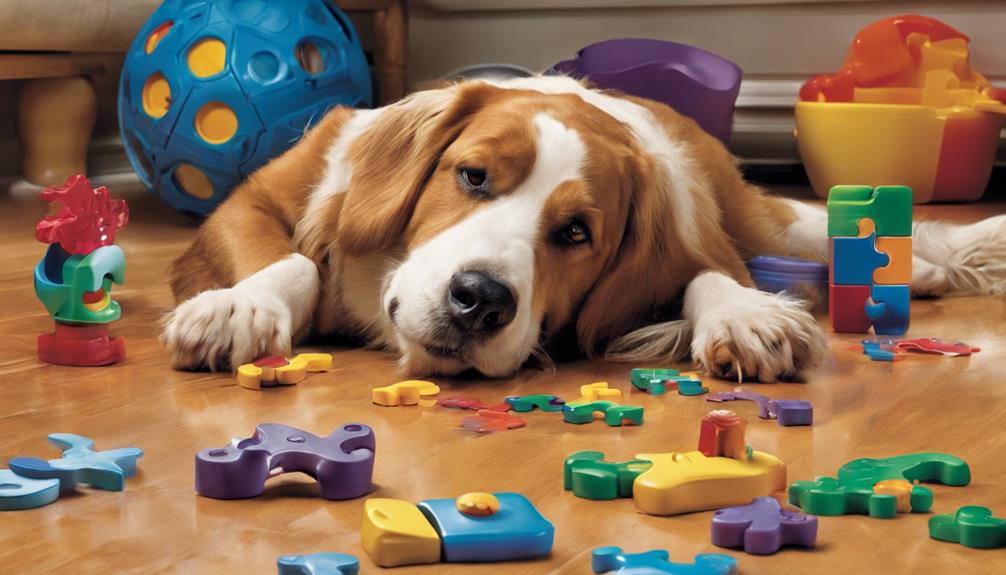When it comes to feeding pork bones to dogs, it's important to avoid risks. Pork bones can easily splinter, leading to choking or blockages. Even big dogs are at risk. For safe alternatives, consider boneless chews like bully sticks or antlers. Supervise your dog's chewing closely and monitor their health afterwards. If your dog ingests a bone, seek immediate vet help. Remember, a vet can guide you on safe bone choices. Opt for raw, large bones, and always watch your dog while they chew. Want more tips for safe feeding? Keep exploring safe practices for your furry friend.
Key Takeaways
- Avoid feeding pork bones due to splintering and choking risks.
- Choose boneless chew options like bully sticks or antlers.
- Monitor dog closely for distress or choking hazards.
- Consult a vet for guidance on safe bone consumption.
- Opt for raw, large bones like cow bones for safer chewing.
Risks of Feeding Pork Bones
Feeding pork bones to dogs poses significant risks due to their tendency to splinter and cause choking hazards. When dogs chew on pork bones, they can break into sharp pieces that may get stuck in the throat or splinter further down the digestive tract. Swallowing these small bone fragments can lead to intestinal blockages, a critical condition that requires immediate veterinary attention.
The sharp edges of pork bones can also cause damage to the esophagus or intestines, resulting in pain and potential infections for our furry friends. Even big dogs, who may try to swallow small pork bones whole, are at risk of serious harm from these hazardous treats.
Given all these dangers, it's essential to prioritize our dogs' safety and well-being by avoiding feeding them pork bones altogether. Let's explore safer alternatives to guarantee our pets stay healthy and happy.
Safe Alternatives for Dogs
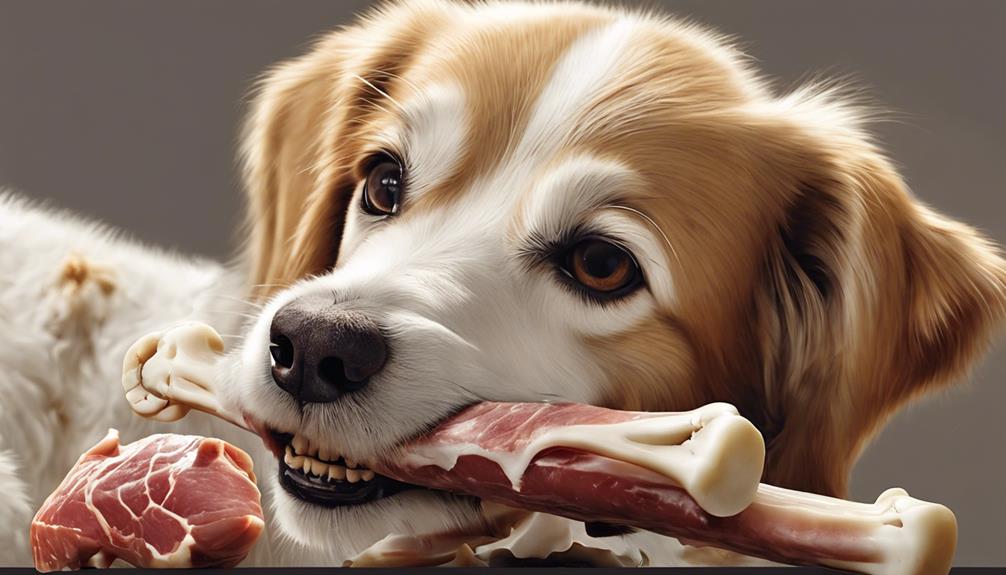
When looking for safe alternatives for dogs, consider boneless chew options or veterinary-approved treats. These options can provide a tasty chewing experience without the risks associated with bone splintering.
Ensuring your dog's safety during chewing sessions is essential for their overall well-being.
Boneless Chew Options
Bully sticks, antlers, and rawhide are popular boneless chew options that provide safe alternatives for dogs. These boneless chews reduce the risks of splintering and choking hazards, making them suitable for dogs who love to chew.
Bully sticks, made from dried bull or steer muscles, offer a long-lasting chewing experience, keeping your furry friend entertained. Antlers, being natural and durable, are perfect for aggressive chewers who need something sturdy to gnaw on. Rawhide chews, available in various shapes and sizes, cater to different dog breeds' preferences.
When offering these boneless chew options to your pets, make sure they're appropriate sizes and supervise their chewing to prevent any potential issues.
Veterinary-Approved Treats
Veterinary-approved treats offer a safe and healthy alternative to pork bones for dogs, ensuring their well-being while providing a rewarding snack option for your furry companion. These treats are specifically formulated to meet the dietary needs of dogs, making them a suitable choice for occasional indulgence.
When considering treats for your pet, it's essential to choose options that are designed with their health in mind. Dogs can eat pork, but in small amounts. To avoid feeding potentially harmful bones, opting for these vet-approved treats is a wise decision.
These snacks come in various flavors and textures, catering to different preferences and ensuring your dog enjoys a tasty reward without compromising their safety.
Monitoring Your Dogs Health
Regularly monitoring your dog's health is important to guarantee their well-being after feeding pork bones. After your dog eats a pork bone, keep a close eye on them for any signs of distress. Watch out for symptoms like vomiting, diarrhea, lethargy, and a lack of appetite.
Additionally, be alert for any indications of intestinal blockage such as abdominal pain, bloating, and difficulty defecating. Any changes in behavior or eating habits should be noted as they could signal a problem.
It's vital to stay vigilant and consult a veterinarian immediately if you observe any concerning symptoms or behaviors in your furry friend. By regularly checking your dog's overall health and well-being, you can make sure they aren't experiencing any issues related to consuming pork bones.
Supervision During Bone Consumption
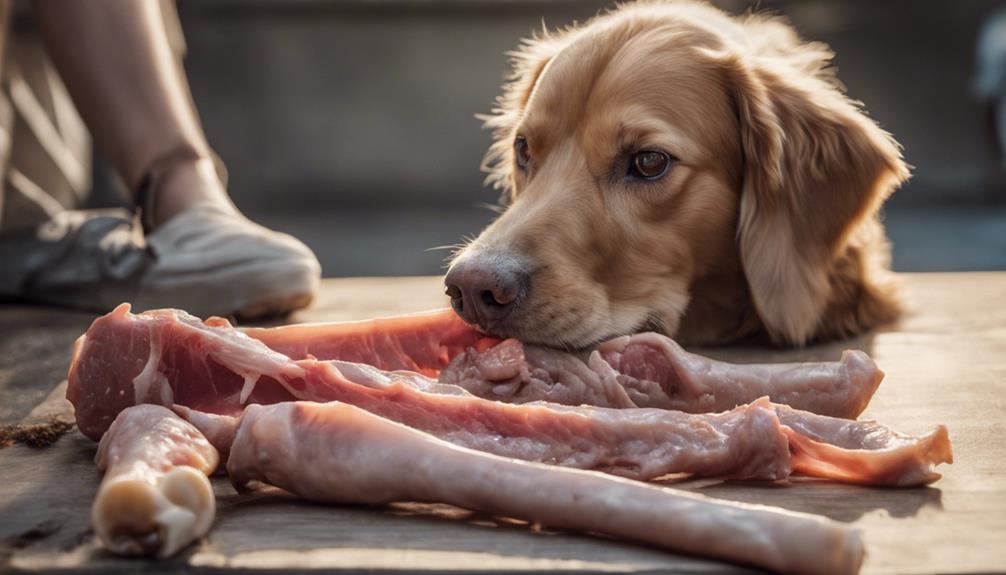
When providing your dog with pork bones, it's essential to keep a close eye on them to make sure they chew the bone safely. Ensure the bone is large enough to avoid any swallowing risks.
Stay alert and be prepared to intervene if necessary during your dog's bone-chewing session.
Watch Dog Closely
While your dog is consuming pork bones, it's crucial to closely supervise their activity to guarantee their safety and well-being.
- Confirm bone size and texture: Pick bones that are appropriate for your dog's size and chewing habits to prevent choking or injuries.
- Watch for signs of distress: Keep an eye out for any discomfort, unusual behaviors, or signs of choking while your dog enjoys the bone.
- Intervene immediately: If you notice splintering, potential hazards, or any signs of distress, act promptly to prevent any harm.
- Monitor closely: Stay attentive throughout the bone consumption process to ensure a safe and enjoyable experience for your furry friend.
Monitor Bone Chewing
To safeguard the safety of your dog, closely monitor their chewing of pork chop bones to prevent any potential accidents or injuries. While your furry friend enjoys gnawing on the bone, keep a watchful eye for any signs of splintering, cracking, or attempts to swallow large pieces.
It's important to confirm the bone is an appropriate size for your dog to prevent choking hazards. By actively overseeing their chewing, you can promptly intervene if you notice any unsafe behavior during consumption.
Remember that monitoring bone chewing not only safeguards against choking but also helps prevent injuries or complications in your dog's digestive tract. Stay vigilant and attentive to make sure your pup enjoys their treat safely.
Precautions With Pork Bone Attachments
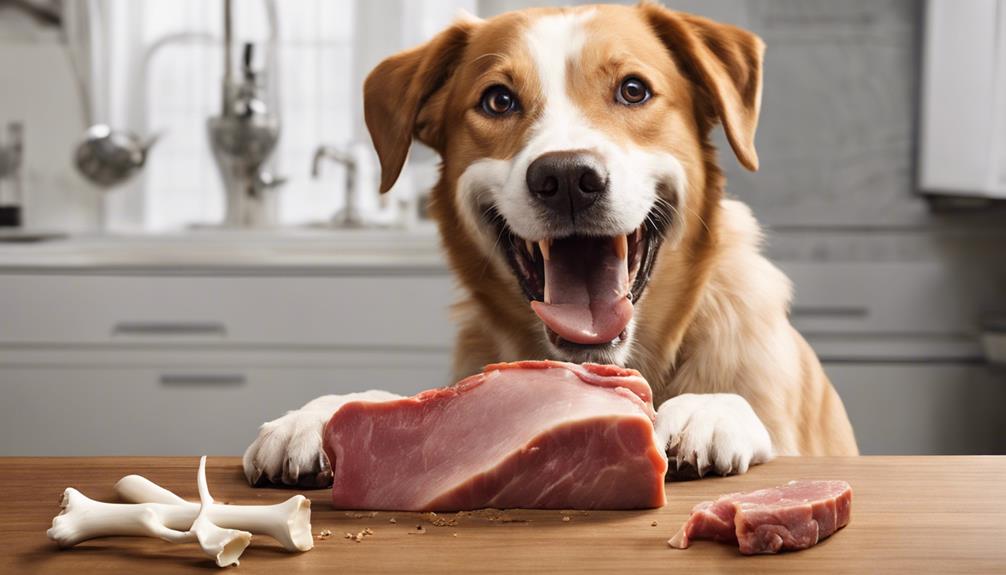
With pork bone attachments, extra caution must be taken to prevent potential risks to your dog's health and safety. When dealing with pork bones, it's essential to keep in mind the following:
- Always remove any small pork bone pieces or attachments before giving the bone to your dog to avoid choking hazards.
- Be cautious of any sharp edges or loose bone fragments that could cause injuries to your dog's mouth, throat, or digestive tract.
- Check the bone thoroughly for any signs of splintering or weakness, as these can lead to dangerous situations when chewed.
- Consider opting for safer alternatives like large, raw cow bones that are less likely to break or splinter, reducing the risk of harm to your furry friend.
Emergency Steps for Ingested Bones
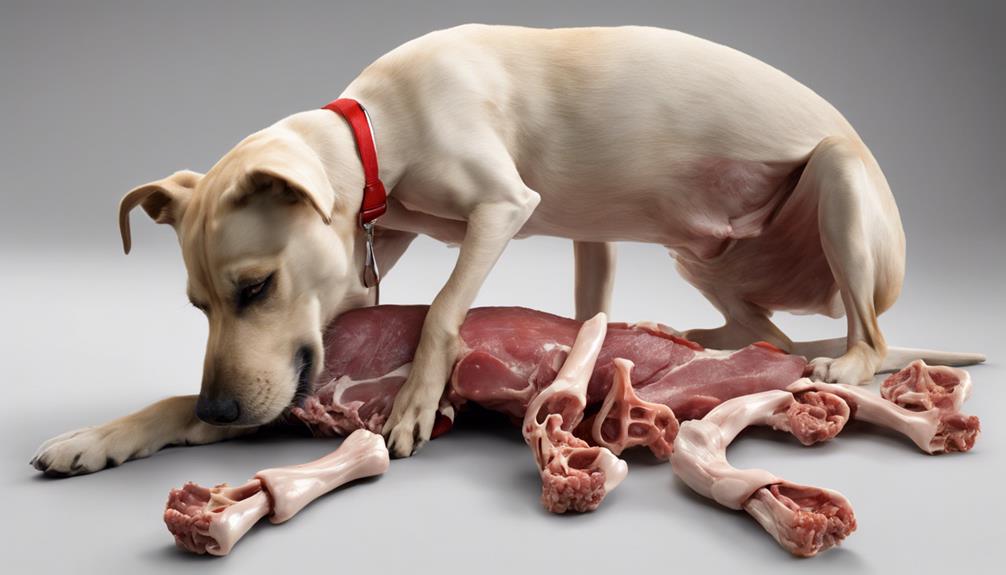
When a dog ingests pork bones, immediate veterinary assistance should be sought to address potential health risks and provide necessary treatment. Contact your vet immediately to get guidance on the next steps.
Try to remove the bone from the dog's mouth if possible to prevent further ingestion. If the bone was raw, rinse the dog's mouth with water to reduce any potential bacteria exposure.
Intestinal blockage is a critical concern, so it's essential to act swiftly. Keep an eye out for symptoms like vomiting, drooling, and abdominal pain.
Monitoring the dog closely for any signs of distress or unusual behavior is vital after bone ingestion. Remember, quick action can help prevent complications like intestinal blockage.
Stay vigilant and prioritize your furry friend's well-being.
Signs of Intestinal Blockage
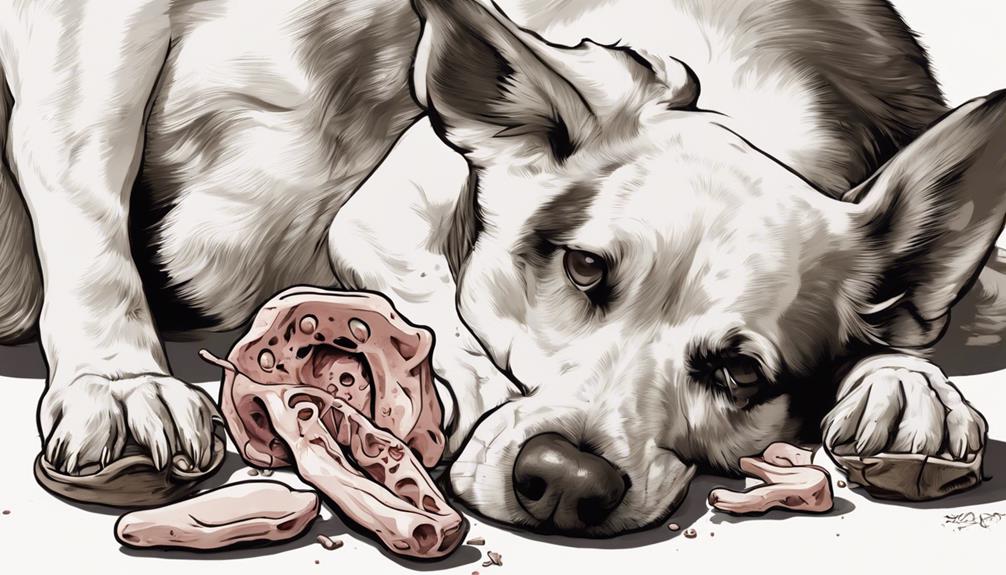
Common signs of intestinal blockage in dogs include vomiting, diarrhea, abdominal pain, and lethargy. If your furry friend displays any of these symptoms, it's essential to act promptly.
Here are some other signs to watch for:
- Dogs with intestinal blockage may show signs of discomfort, restlessness, and reluctance to eat or drink.
- Constipation, bloating, and straining during bowel movements can indicate a possible intestinal blockage in dogs.
- A distended abdomen, hunching over, and whining can be symptoms of intestinal blockage in dogs.
- If you suspect your dog has an intestinal blockage, seek immediate veterinary attention to prevent serious complications.
Importance of Veterinary Care

Seeking veterinary care when feeding pork bones to dogs is vital for ensuring their safety and well-being. Vets play an important role in providing guidance on the risks associated with pork bones. They can offer personalized advice based on your dog's individual needs. Regular check-ups with a vet are essential to monitor your dog's health and address any concerns related to bone consumption.
Vets can suggest alternative bone options or safe ways to introduce pork bones to your dog's diet. In case of complications or emergencies, immediate veterinary care can greatly impact your dog's recovery. Remember, a vet is your best ally in keeping your furry friend safe and healthy when it comes to bone consumption. Prioritize veterinary care to guarantee your dog enjoys pork bones without any harm or risks.
Final Tips for Bone Safety

To ensure your dog's bone safety, it's essential to follow these final tips for selecting and supervising bone chewing sessions.
- Choose Wisely: Opt for raw, large bones such as cow or bison to minimize the risk of splintering.
- Supervise Carefully: Keep a close eye on your dog while they chew bones to prevent any accidents or mishaps.
- Avoid Swallowing Hazards: Refrain from giving small bones that can be swallowed whole, potentially causing choking.
- Consult the Vet: Always seek guidance from your veterinarian for specific instructions on safely incorporating bones into your dog's food.
Frequently Asked Questions
How Do You Make Pork Bones Safe for Dogs?
To make pork bones safe for dogs, choose raw, large bones to minimize splintering. Always supervise your dog while they chew and avoid cooked bones to prevent hazards.
Watch for any signs of distress and consult your vet before adding pork bones to your dog's diet. Prioritize your dog's safety by following these guidelines and ensuring a healthy chewing experience.
Will My Dog Be Okay if He Ate a Pork Bone?
If your dog consumed a pork bone, immediate veterinary attention is essential. Swallowing bones can result in serious health issues like choking and blockages. Watch for symptoms of distress such as vomiting and lethargy.
It's important to act quickly and seek professional help to avoid complications. Remember, prevention is key – choose safer bone alternatives to keep your furry friend healthy and happy. Your dog's well-being is top priority, so don't hesitate to seek help if needed.
What Can I Give My Dog to Help Pass a Bone?
When it comes to helping your dog pass a bone, it's important to take some steps to ease the process.
You can give your furry friend bread to cushion and push the bone through. Additionally, fiber-rich foods like pumpkin or sweet potatoes can aid in passing the bone smoothly.
Make sure your dog drinks plenty of water to help move the bone along. Consulting a vet for advice on digestive aids can also be beneficial.
How Do You Feed a Dog Raw Bone?
When feeding a dog raw bone, it's important to choose large, raw bones like cow or bison to lessen splintering risks. Make sure the bone is larger than the dog's mouth to avoid choking hazards. Monitor closely while your dog chews to oversee safe consumption.
Raw bones are safer than cooked bones, as they're less likely to splinter. Follow guidelines to prevent accidents or injuries. Always prioritize your dog's safety when giving them bones.
Can feeding pork bones to dogs lead to tomato poisoning?
Feeding pork bones to dogs can result in serious health issues, including the risk of treating tomato poisoning in dogs. Pork bones can splinter and cause intestinal blockages, while tomatoes contain toxins harmful to dogs. It’s best to avoid feeding pork bones and tomatoes to dogs to prevent potential poisoning.
Conclusion
To summarize, keep in mind that 'an ounce of prevention is worth a pound of cure.'
When offering pork bones to your dog, always prioritize safety by selecting suitable bones, closely monitoring their consumption, and seeking veterinary care if necessary.
By adhering to these guidelines and staying proactive, you can guarantee your furry companion enjoys a tasty treat without any risks or complications.
Your dog's health and well-being should always take precedence.
